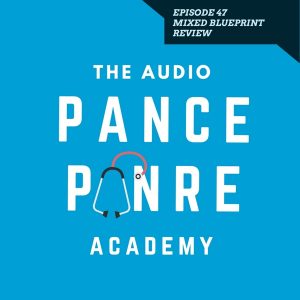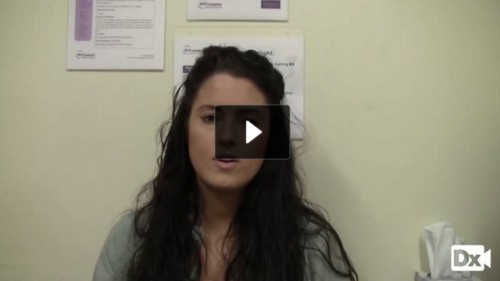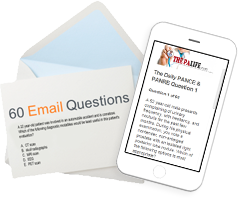Podcast: Play in new window | Download
Subscribe: Apple Podcasts | RSS
 Welcome to episode 47 of the FREE Audio PANCE and PANRE Physician Assistant Board Review Podcast.
Welcome to episode 47 of the FREE Audio PANCE and PANRE Physician Assistant Board Review Podcast.
Join me as I cover 10 PANCE and PANRE board review questions from the Academy course content following the NCCPA™ content blueprint (download the FREE cheat sheet).
This week we will be covering 10 general board review questions based on the NCCPA PANCE and PANRE Content Blueprint.
Below you will find an interactive exam to complement the podcast.
I hope you enjoy this free audio component to the examination portion of this site. The full genitourinary board review includes over 72 GU specific questions and is available to all members of the PANCE and PANRE Academy and SmartyPANCE
- You can download and listen to past FREE episodes here, on iTunes or Stitcher Radio.
- You can listen to the latest episode, take an interactive quiz and download your results below.
Listen Carefully Then Take The Quiz
If you can’t see the audio player click here to listen to the full episode.
Episode 47 PANCE and PANRE Podcast Quiz
The following 10 questions are linked to NCCPA Content Blueprint lessons from the SmartyPANCE PANCE and PANRE board review website. If you are a member and login you will be able to view this content.
1. To relieve dependent edema in a pregnant patient, which of the following should be instituted as treatment?
- Limit fluid intake
- Elevate the legs
- Prescribe thiazide diuretics
- Strict avoidance of sodium
Uncomplicated pregnancy is part of the NCCPA Content Blueprint Reproductive System which is 8% of the exam
2. To further assess ascites in a patient, the physician assistant instructs the patient to turn onto one side while performing percussion. Which of the following is the reason for this maneuver?
- Testing for shifting of dullness on percussion
- Shifting of internal organs making percussion easier
- Trying to elicit any pain while moving
- Trying to produce a caput medusae
Ascites is a common complication of liver disease. Disorders of the liver is part of the NCCPA GI and Nutrition Content Blueprint and represents 10% of the exam
3. A 7-year-old child with a history of type 1 diabetes mellitus for 3 years presents for routine follow-up. The mother states that the child has been having nightmares and night sweats. Additionally, his average morning glucose readings have risen from an average of 100 mg/dL to 145 mg/dL over the past week. This child is most likely experiencing
- a growth spurt
- emotional problems
- the Somogyi effect
- the dawn phenomenon
Diabetes mellitus type 1 is part of the NCCPA Content Blueprint Endocrinology which represents 6% of your exam
4. A patient complains of loss of sensation at the level of the umbilicus. Which of the following dermatomes is affected?
- T6
- T8
- T10
- T12
Radicular pain is a common symptom of a herniated nucleus pulposus covered as part of the NCCPA Content Blueprint Musculoskeletal System which is 10% of your exam
5. A 25-year-old female graduate student presents to the student health center for the eighth time in three weeks to be sure she does not have meningitis. She read that there was a student on campus who had meningitis last month, and now she has headaches and is requesting to be tested to make sure she does not have meningitis. She has been evaluated at each visit, and physical examination has been completely normal each time. Which of the following is the most likely diagnosis?
- Conversion disorder
- Hypochondriasis
- Malingering
- Somatization disorder
Somatoform disorders are covered as part of the NCCPA Content Blueprint Psychiatry which is 6% of your exam
6. What is the mechanism for the relapsing fevers associated with malaria?
- Release of malarial merozoites into the bloodstream
- Release of toxins from Plasmodium species
- Attachment of Plasmodium species to receptor sites on the red blood cells
- Invasion of hepatocytes by Plasmodium species
Malaria is covered as part of the NCCPA Content Blueprint Infectious Disease and is 3% of the exam
7. A 29-year-old patient with idiopathic thrombocytopenia purpura (ITP) is treated with prednisone therapy. Despite therapy, platelet counts remain consistently below 20,000/microliter over the course of 6 weeks. Which of the following is the most appropriate intervention for this patient?
- Aspirin
- Intravenous immunoglobulin
- Danazol (Danocrine)
- Splenectomy
Idiopathic thrombocytopenic purpura is covered as part of the NCCPA Content Blueprint Hematology and is 3% of your exam
8. A 27 year-old female presents to your office for evaluation of weakness, visual loss, and sensory loss over the right great toe. These symptoms have occurred during three episodes approximately three months apart with each episode lasting about three days. Which of the following tests would be most useful in further evaluating this patient?
- MRI of the brain
- Electromyography
- Glucose tolerance test
- Electroencephalograph
This condition is covered as part of the NCCPA Content Blueprint Neurology which is 6% of your exam
SmartyPANCE ReelDx + members can view this real-world case!
9. A patient taking bleomycin (Blenoxane) should be monitored for which of the following side effects?
- Optic neuritis
- Hyperuricemia
- Encephalopathy
- Pulmonary fibrosis
This condition is is covered as part of the NCCPA Pulmonary Content Blueprint which represents 12% of your exam
10. A patient presents for a follow-up visit for chronic hypertension. Which of the following findings may be noted on the fundoscopic examination of this patient?
- cherry-red fovea
- boxcar segmentation of retinal veins
- papilledema
- arteriovenous nicking
This condition is a common complications of chronic hypertension covered as part of the NCCPA Cardiology Content Blueprint which is 16% of your exam
Looking for all the podcast episodes?
This FREE series is limited to every other episode, you can download and enjoy the complete audio series by joining The PANCE and PANRE Exam Academy + SmaryPANCE
I will be releasing new episodes every few weeks. The Academy is discounted, so sign up now.
Resources and Links From The Show
- Join the PANCE and PANRE Academy + Smarty PANCE
- My list of recommended PANCE and PANRE review books
- Download the FREE PANCE and PANRE Blueprint Checklist
- Sign up for the FREE daily PANCE and PANRE email series
- The Smarty PANCE NCCPA Content Blueprint Website + The PA Life Academy
- USE CODE “PALIFE” TO GET 10% OFF THE RUTGERS PANCE AND PANRE REVIEW COURSE
This Podcast is also available on iTunes and Stitcher Radio for Android
- iTunes: The Audio PANCE AND PANRE Podcast iTunes
- Stitcher Radio: The Audio PANCE and PANRE Podcast Stitcher
Download The Content Blueprint Checklist
Follow this link to download your FREE copy of the Content Blueprint Checklist
Print it up and start crossing out the topics you understand, marking the ones you don’t and making notes of key terms you should remember. The PDF version is interactive and linked directly to the individual lessons on SMARTY PANCE.


